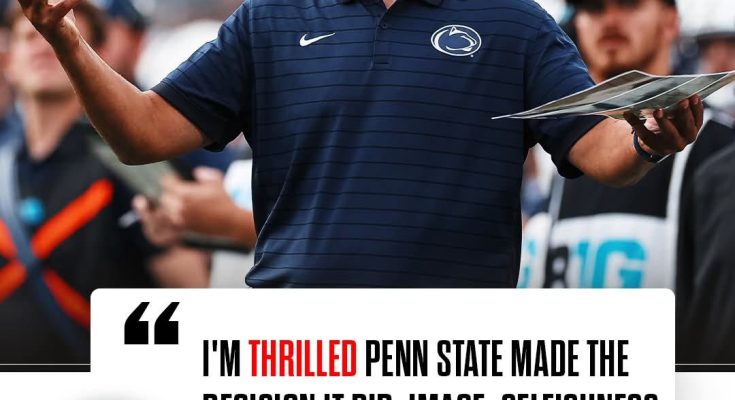When Todd McShay publicly declared that he was “thrilled Penn State made the decision it did,” he wasn’t just reacting to a change at the top — he was laying bare a deeper indictment of James Franklin’s tenure. McShay didn’t mince words: “Image, selfishness, agenda — eventually that kind of leadership rears its ugly head,” he said, then added, “I think James Franklin got away with it for entirely too long.
Those statements speak not only to Franklin’s failures but to what McShay—and others—saw as the toxic underbelly of his leadership. To understand why McShay’s comments resonate (or inflame), it helps to parse what he meant by “image, selfishness, agenda” and “got away with it.”
First, the criticism of “image.” Franklin, over more than a decade at Penn State, cultivated a polished public persona: charismatic, media-savvy, protective of his brand. That was part of his appeal. But McShay suggests that the image was not just a tool — in some respects, it became a mask, concealing deeper issues: priorities that skewed toward optics, self-promotion, and controlling narratives, rather than confronting structural weaknesses and holding people (including himself) accountable.
“Selfishness” is perhaps a harsher charge — the idea that Franklin’s decisions, public statements, and overall leadership might serve his interests first: preserving reputation, deflecting criticism, maximizing his legacy. In an environment as high-stakes as major college football, every coach walks a tightrope between protecting their program and protecting themselves. McShay seems to argue that Franklin tilted too far toward self-protection.
“Agenda” is a loaded word: it connotes ulterior motives, internal politics, power dynamics. McShay’s use of it implies that Franklin wasn’t just coaching — he was managing optics, managing narratives, possibly managing expectations and loyalties — in ways that sometimes overshadowed pure football concerns. When McShay says that kind of leadership “rears its ugly head,” he means that eventually those internal calculations and compromises manifest in breakdowns: in recruiting missteps, staff discord, underperformance in big games, or losing the locker room.
When McShay says Franklin “got away with it entirely too long,” he is asserting that these problems were persistent, long-festered, perhaps widely known but unaddressed or unpunished — that Franklin was allowed to persist through periods of underperformance without sufficient accountability until the situation was too dire to ignore.
McShay’s blistering critique gains weight when viewed against Franklin’s record, strengths, and persistent fault lines. Franklin’s time at Penn State included high points: he rebuilt and retained relevance in a storied program, won a Big Ten title, secured multiple New Year’s Six bowl appearances, and last season even reached the College Football Playoff semifinals. (CBS Sports) But amid those accomplishments were recurring criticisms that dogged him: his inability to win consistently against elite programs, shaky performances at critical moments, and bouts of inconsistency. (CBS Sports)
One longtime critique is Franklin’s struggles in big games: among top‑10 opponents, the numbers are discouraging. (CBS Sports) When a program like Penn State aspires to national titles, those marquee matchups matter. Coaches often get judged not just by regular success, but by whether they can deliver against the best, in the toughest moments. Franklin’s weakness in those moments fueled frustration.
Another undercurrent is that Franklin’s strengths lay in recruiting, culture-building, and maintaining competitiveness — but his deficits often surfaced in staff cohesion, offensive and defensive breakdowns at key times, or inability to adapt under pressure. Over time, fans and insiders began to question whether he was taking shortcuts, whether coordinators were doing the heavy lifting, and whether Franklin was too focused on image, messaging, and control rather than growth and course correction.
McShay’s critique suggests he believes Franklin’s problems weren’t one‑off or tied to just one bad season—they were baked in. They simmered for years, tolerated because the wins and recruiting success masked deeper rot. In that framing, Franklin was protected by his success, given latitude until the margin for error evaporated.
Let’s look at Penn State’s decision-making: to fire Franklin midseason after three straight losses — including a home defeat to Northwestern by one point, following a loss to winless UCLA — is dramatic. (Reuters) The Nittany Lions had started this season as the No. 2 team in preseason rankings. (Reuters) The slide was stark: a 3–3 record overall, 0–3 in Big Ten play. (CBS Sports) From that vantage, the administration likely believed that the trajectory was untenable.
But replacing a coach midseason with a massive buyout is no small move: Franklin’s buyout reportedly exceeds $49 million, making it one of the largest coaching buyouts in college football history. (ESPN.com) The financial commitment underscores how dire the university viewed the situation. The decision, in effect, signals that leadership believed Penn State could not afford more of the same—even for a coach who had built a solid legacy.
McShay, by framing the firing as both overdue and morally necessary, is placing Penn State’s decision within a broader theme in college sports: eventually, programs demand authenticity, accountability, and consistency—not just charisma and winning on paper. Image and branding can only carry you so far when performance, culture, and trajectory become dangerously misaligned.
His commentary also invites reflection about the risks of staying too long. Even successful coaches who build strong reputations risk complacency, whisper networks of discontent, cults of personality that resist scrutiny. McShay appears to argue Franklin crossed that threshold: he lingered too long after failures accumulated, and the internal cracks got too big.
Of course, McShay’s take is not uncontested. There are many who will defend Franklin. Some will argue that in a program like Penn State, with high expectations, nearly any coach is held to impossible standards. Others point to the volatility of college football—injuries, one or two bad calls, staff turnover—that can derail seasons. And some will note that Franklin’s strengths—recruiting, player development, program visibility—are assets that many schools would trade for.
Still, McShay’s voice matters because he doesn’t strike the usual balance of criticism and praise. He went “all-in” with the critique, making it personal and systemic. He’s not just saying Penn State made a tough call; he contends it was overdue, overdue because Franklin’s behavior and leadership style had become liabilities that the team and program could no longer accommodate.
For Penn State, the hard part now begins. Having severed with Franklin, they must hire someone who can win big games, sustain recruiting prowess, and avoid the pitfalls that McShay and others cite. They must restore trust with donors, fans, recruits, and players. They must contend with the narrative that Franklin was allowed too much latitude for too long—and ensure the next hire doesn’t repeat that pattern. The new coach must command results, but also embody culture, accountability, and consistency.
And for Franklin, this represents a forced reckoning. What was once a decorated tenure now ends with swirling controversy, massive payout, and harsh public critique. His supporters will highlight the highs—bowl wins, competitive squads, program stability. His critics will sharpen their cases. In either view, his legacy will be reexamined: was he a visionary who outgrew the role, or a coach who outstayed his usefulness?
McShay’s remarks will stoke debate for weeks, months, years. But his central point—that James Franklin “got away with it too long”—will linger as a charge: that the failures, cracks, and personal leadership problems weren’t surprises but long-ignored warnings.
In the end, Penn State’s decision to fire Franklin signals a reset, a gamble that swapping goodwill and legacy for structural demands and expectations is worthwhile. Whether it pays off will depend on whether the next leader avoids Franklin’s pitfalls and whether the program can rise above the narratives of image over substance.
McShay’s words, harsh though they are, provoke an important question for all elite programs: when does charisma become a cover? When does success blind us to flaws? And how long can you coast on brand before performance demands catches up?
Penn State has drawn a line in the sand. McShay says it should have been drawn earlier. Time will tell who was right—and whether the next chapter validates or refutes McShay’s fiery take.


